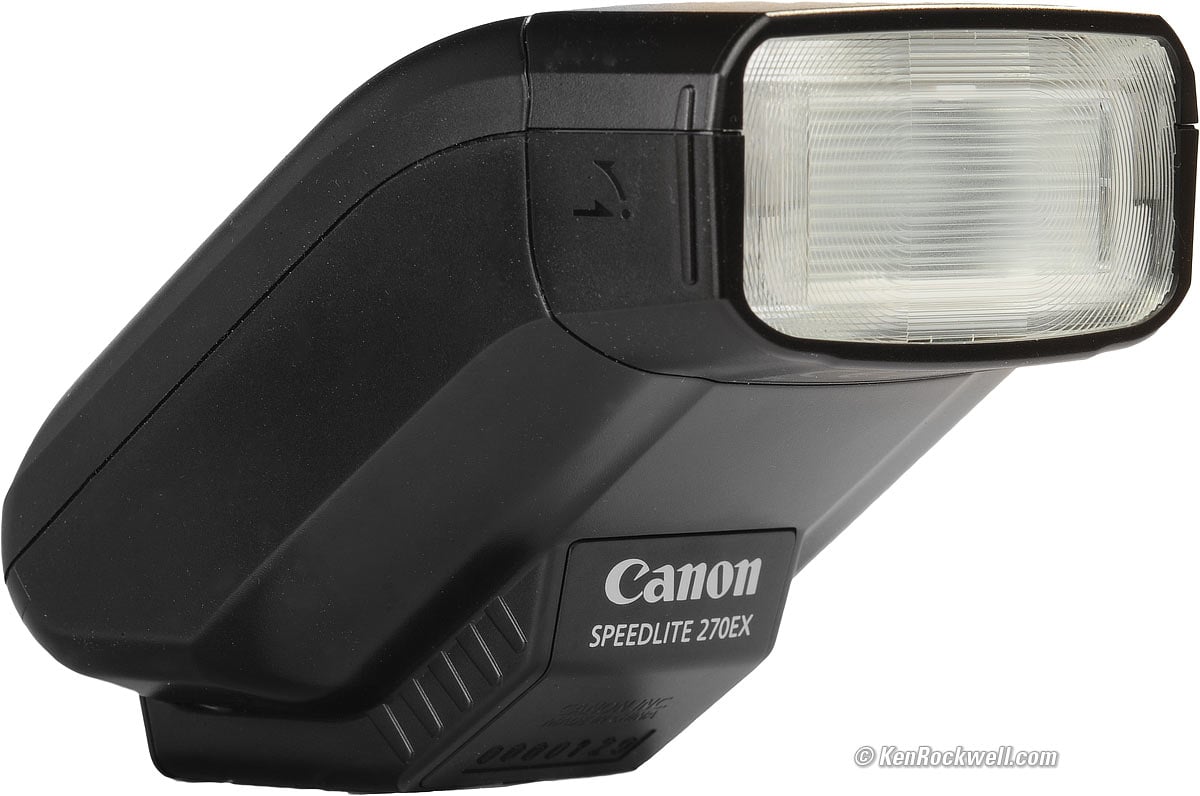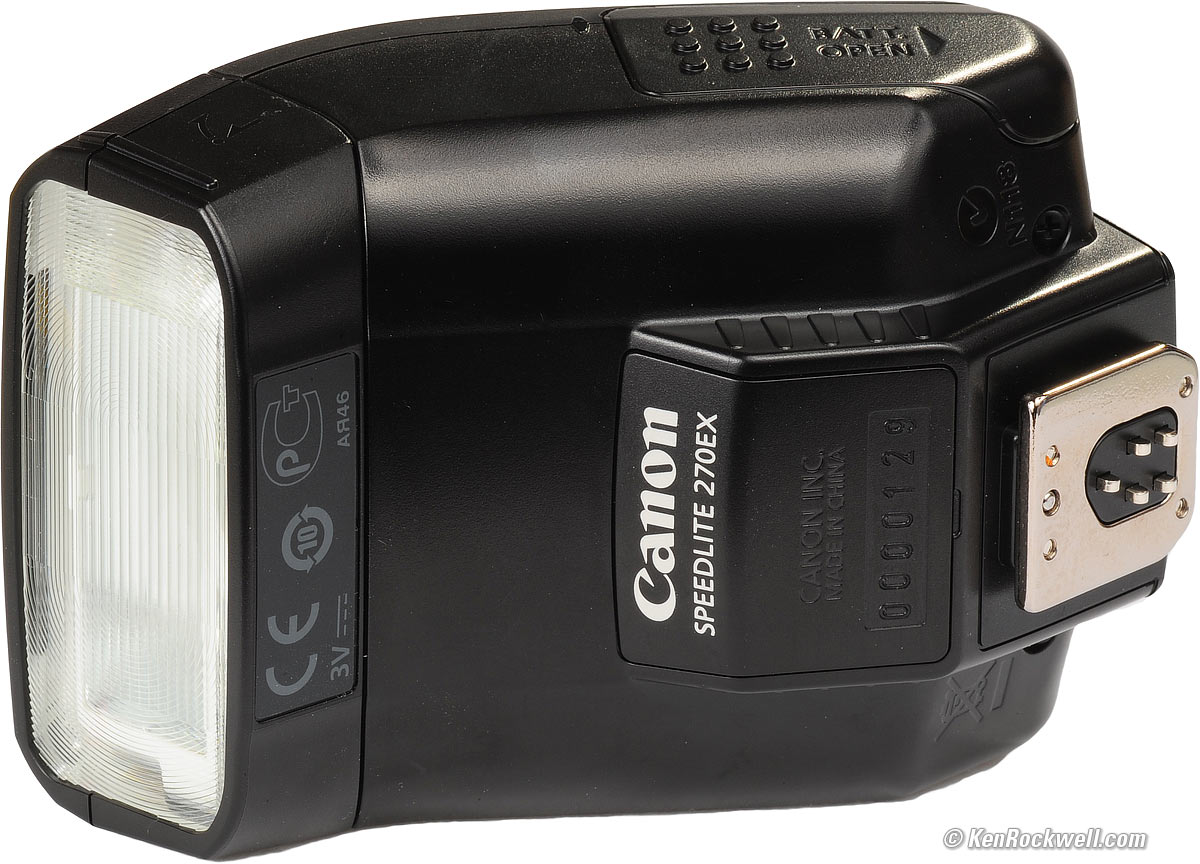Home Donate New Search Gallery How-To Books Links Workshops About Contact
Canon 270EX
Speedlite
(2009-2011)
Intro Specs Performance Compared Recommendations
Canon 270EX flash (2-AA cells, 6.9 oz./195g with batteries, 3.9 seconds measued recycle time, measured ISO 100 guide number 20 meters/67 feet, about $50 used if you know How to Win at eBay or $179 new at Amazon). enlarge. My biggest source of support is when you use those or any of these links when you get anything, regardless of the country in which you live. It helps me keep adding to this free website when you get anything through these links — but I receive nothing for my efforts if you take the chance of buying elsewhere. Thanks for your support! Ken.
April 2018 Canon Reviews Canon Lenses Canon Flash All Reviews
NEW: Canon 270EX II, which seems to be the same thing.
Compared to Canon's and Nikon's other small flashes
Introduction top
Intro Specs Performance Compared Recommendations
|
|
The Canon 270EX Speedlite is a small, inexpensive and sturdy little flash for any of Canon's DSLRs. It even has a tiny manual zoom head, and bounces vertically.
It will not work on Canon's older film EOS cameras that use the TTL autoflash mode. This 270EX flash only works in E-TTL and E-TTL II modes.
All functions, like exposure compensation, rear sync, high-speed sync and manual power output are controlled by the camera and its menu system.
Unfortunately, it has two tiny little flaws which are big problems. I suggest the older Canon 220EX instead, which fixes these, and also works on older cameras.
Problem 1
The 270EX flash doesn't stay charged very long after it goes to sleep. If you try to take a picture a few minutes later, you often have to wait a couple of seconds for the flash to recharge. This can lose pictures, since you try to take the picture, and the flash is not yet ready.
I thought I was crazy, but after testing this in the lab to confirm my sanity by turning on the flash, waiting ten minutes, and then tapping the shutter button to wake it up, my old beater Canon 220EX flash is ready in just 3/4 of a second, and my Nikon SB-400 is ready to go immediately.
After the same ten minutes, this new 270EX takes a full two seconds to recharge itself. Each Canon flash goes to sleep after 90 seconds, so by ten minutes I mean that the flashes have been in standby mode for 8.5 minutes.
With my kids doing cute things without notice, I don't have two seconds to wait after I bring the camera to my eye. I've lost quite a few photos because the 270EX doesn't stay charged very long after it goes into standby mode.
Even after several hours, the Nikon SB-400 is still ready the instant I wake up the camera. There is no "dead time" where the flash isn't available after waking up a camera from standby.
In my comparison chart, I refer to the time required for the flash to be ready again after about ten minutes idle as "Wake-up Time."
Two seconds is too long, when the 220EX takes only 3/4 of a second, and the SB-400 takes no time at all to wake after several minutes of sleep.
Regular recycle time, meaning how long it takes to recharge after taking a picture, is about the same as other flashes, although if you use a lot of flash power, the 270EX is again slower than other similar flashes. This is also tested in my comparison table, as "Recycle Time."
Problem 2
There is no AF illuminator beam. Sadly, the 270EX is styled to look like there is an illuminator below the flash tube, but it doesn't have one. It almost looks like there was going to be one, and then it got taken out before the design process was complete.
Instead, the 270EX fires nearly the full power of the flash in multiple bursts as your camera attempts to focus in very dim light.
This is even more annoying than the a single flash burst itself when taking a picture.
To disable this on a 5D Mark II look for Custom Function III-5-1.
By comparison, the 220EX has a real red LED illuminator which is rated to have an even greater range, is far less annoying, and doesn't use flash power to get ready to shoot.
The 270EX flash can fire these bursts as you hit various camera buttons without taking a picture, which is the surest way to get yourself kicked out of someplace even before you take any pictures!
Problem 3
If you tap your camera's depth-of-field preview button, even by accident as you change lenses, the flash fires off a long, extended full-power burn, which can blind you or damage your vision at close range.
Nikons do the same stupid thing, but at least there's a menu option to turn it off, and newer Nikons default this option to OFF. With my 5D Mark II, I couldn't find a menu option to rectify this defect. The is a safety defect because it defaults to ON, not OFF. (Hint: readers report that this option might be in the WRENCH •• menu, Flash C. Fn. setting 3 under "External Speedlite control," not the flash menu where it belongs.)
In Japan, this defect is called a "modeling light," and pitched as a feature.
Rear, Canon 270EX Speedlite. enlarge.
Specifications top
Intro Specs Performance Compared Recommendations
See also my Small Flash Comparison Table for more data and features.
Name
Canon calls this the CANON Speedlite 270EX.
Flash Control Systems
E-TTL, E-TTL II.
There is no TTL mode for use with older film cameras.
Bounce Angles
Vertical only.
60,º 75º and 90º click stops.
Recycle time
Rated 3.9 seconds or less, fresh alkaline batteries.
That's what I measured, with Ni-MH cells.
Rated Output Power
GN 22 meters, 72 feet at ISO 100, with the zoom head at its default 28mm setting.
With the manual zoom head set to the extended 50mm position, it's rated as 27 meters, 89 feet, at ISO 100.
Batteries
Two AA cells.
Alkaline, Ni-MH, and lithium are all good.
Battery life
Rated 100 shots minimum at full-power, 680 maximum, on alkalines.
Standby Time-out
90 seconds.
Rated Coverage
28mm or 50mm, manual zoom head, full-frame.
On 1.6x cameras, this corresponds to 18mm or 31mm.
On 1.3x cameras, this corresponds to 22mm or 38mm.
AF Assist. Illuminator
No, uses annoying blasts of the flash itself instead.
These annoying blasts do cover all the AF sensors, but the blasts are too annoying or revealing to use in public.
Exposure Confirmation Light
None.
Size top
Canon specifies 2.6" (65mm) tall by 2.5" (64mm) wide by 3" (76.5mm) deep.
Weight top
6.925 oz. (196.3g), measured with two Sanyo AA Eneloop Ni-MH HR-3UTGcells.
6.825 oz. (193.5g), measured, with two Duracell AA alkaline cells (MN1500).
5.080 oz. (144.1g), measured, empty.
Canon specifies 5.1 oz. (145g) empty.
Accessories top
Drawstring pouch, included.
Introduced top
2009.
Price, USA top
April 2018: about $50 used if you know How to Win at eBay or $179 new at Amazon
February 2014: $200 new at Amazon.
May 2010: $150.
Performance top
Intro Specs Performance Compared Recommendations
Overall performance top
Excepting the big little problems mentioned at the beginning, everything else works great on this tough and flexible little flash.
If it weren't for the slightly bigger and older 220EX working better, I'd give this 270EX high marks.
Measured Power Output performance top
I'm impressed. While not much stronger than its direct competition, it tests much closer to its ratings than most other flashes.
GN 20.4 meters, 67 feet, at standard 28mm setting. (22 meters, 72 feet, rated.)
GN 25.9 meters, 85 feet, at extended 50mm setting. (27 meters, 89 feet, rated.)
Recycle Time performance top
3.9 seconds after a full-power blast, measured, with two freshly charged Sanyo Eneloop HR-3UTG Ni-MH cells.
Wake-up Time performance top
As covered above, when the 270EX flash goes to sleep, the charge drains from its capacitor faster than other flashes, so after several minutes, you often have to wait a few critical moments after waking up the camera for the 270EX to be ready.
I measured 2 seconds after a 10 minute rest. Other flashes take less than a second to be ready after 10 minutes, or hours.
This is a serious problem for me with the 270EX, and why I prefer the older 220EX instead.
Ergonomics and Usage performance top
Except for the maddeningly long wake-up time, everything else is great.
Power Switch
The power switch is perfect: it slides on or off instantly.
Zoom and Bounce
The zoom and bounce functions are also easy to adjust, just move them.
To point the flash head up, you first must pull-out the zoom head to 50mm.
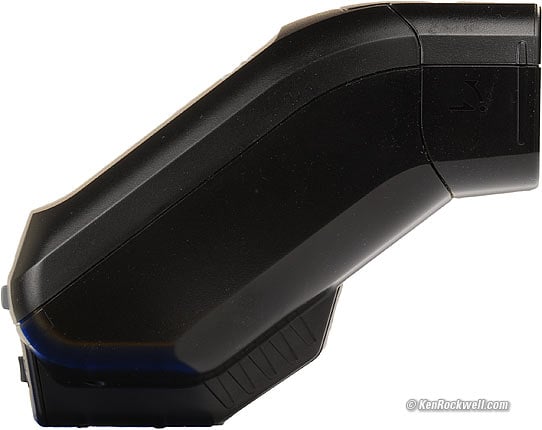
Canon 270EX at default 28mm setting.
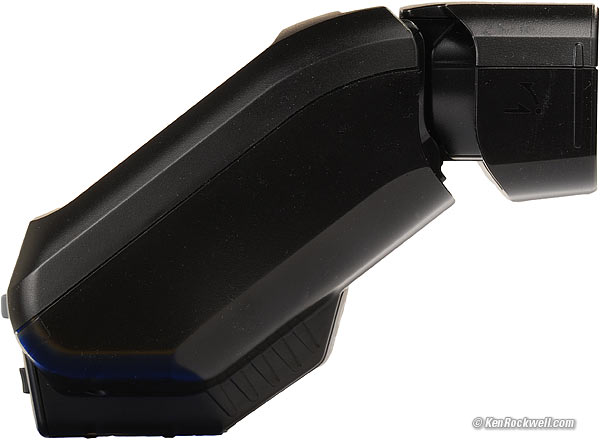
Canon 270EX at 50mm setting (head pulled forward).
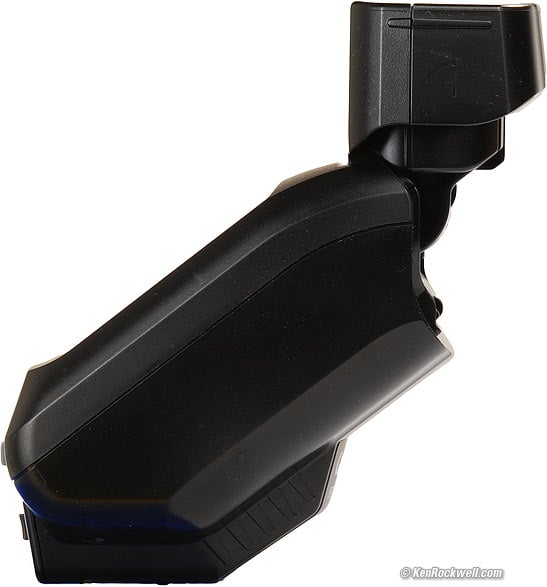
Canon 270EX set to 90º bounce.
Quickflash
A silly feature never explained in the manual is called "Quickflash." This allows the flash to fire at reduced output, with the correct exposure, more quickly than waiting for a full recycle time.
When you first turn-on the 270EX, you'll first see a blinking ready light after about 2.5 seconds, and then a solid ready light after about 4 seconds.
The blinking light in 2.5 seconds means that the flash and camera are happy, and so long as you're within a shorter range than you could be with a full-power flash, everything will work fine.
The problem with Quickflash is that it doesn't help with the cripplingly long wake-up time after the flash has been idle. I still lose shots because I expect the flash to be ready instantly after the camera has been idle, which it usually is with the older 220EX.
Shoe Lock
Just slide the switch to the right. It works great; I never had it come out.
Manual Power Output Setting
You set this in your camera's menus.
Exposure Compensation
You set this in your camera's menus.
Slow Sync
You set this in your camera's menus.
High-Speed (FP) Sync
You set this in your camera's menus.
This only works in your camera's manual or Tv exposure modes.
In this mode, the 5D Mark II shows a little "H" next to the flash bolt in the finder.
Mechanics performance top
Bottom, Canon 270EX. enlarge.
The Canon 270EX is mostly tough plastic, with a metal lock pin and a metal plate for its shoe, screwed into the plastic housing.
It's small, but tough. Even its little battery door inspires more confidence than the flimsier build of the 220EX.
I wouldn't worry about breaking this flash any more than any other Canon pro flash.
Noises When Shaken
Very faint clicking.
Made in
China.
Recommendations top
Intro Specs Performance Compared Recommendations
This is a great little flash for carry atop your 5D Mark II or other DSLR as a fill-flash, except for its slow wake-up time and annoying flash bursts for AF assist.
I'd buy the recently discontinued 220EX instead, which is still available brand-new, for less money.
See also my Small Flash Comparison for more test data and features.
More Information:
© Ken Rockwell. All rights reserved. Tous droits réservés. Alle Rechte vorbehalten.
Help Me Help You
I support my growing family through this website, as crazy as it might seem.
The biggest help is when you use any of these links when you get anything. It costs you nothing, and is this site's, and thus my family's, biggest source of support. These places always have the best prices and service, which is why I've used them since before this website existed. I recommend them all personally.
If you find this page as helpful as a book you might have had to buy or a workshop you may have had to take, feel free to help me continue helping everyone.
If you've gotten your gear through one of my links or helped otherwise, you're family. It's great people like you who allow me to keep adding to this site full-time. Thanks!
If you haven't helped yet, please do, and consider helping me with a gift of $5.00.
As this page is copyrighted and formally registered, it is unlawful to make copies, especially in the form of printouts for personal use. If you wish to make a printout for personal use, you are granted one-time permission only if you PayPal me $5.00 per printout or part thereof. Thank you!
Thanks for reading!
Mr. & Mrs. Ken Rockwell, Ryan and Katie.
